Manipulation of the Martensitic Transformation and Exchange Bias Effect in the Ni45Co5Mn37In13 Ferromagnetic Shape Memory Alloy Films
Abstract
:1. Introduction
2. Experiment Details
2.1. Preparation of Ni-Co-Mn-In Alloy Target Material
2.2. Preparation of Ni-Co-Mn-In Alloy Films
3. Results and Discussion
4. Conclusions
Author Contributions
Funding
Institutional Review Board Statement
Informed Consent Statement
Data Availability Statement
Conflicts of Interest
References
- Wei, Z.Y.; Shen, Y.; Zhang, Z.; Guo, J.P.; Li, B.; Liu, E.; Zhang, Z.D.; Liu, J. Low-pressure induced giant barocaloric effect in an all-d-metal Heusler Ni35.5Co14.5Mn35Ti15 magnetic shape memory alloy. APL Mater. 2020, 8, 051101. [Google Scholar] [CrossRef]
- Yang, Q.; Zhou, Z.; Sun, N.; Liu, M. Perspectives of voltage control for magnetic exchange bias in multiferroic heterostructures. Phys. Lett. A 2017, 381, 1213–1222. [Google Scholar] [CrossRef]
- Zhao, X.; Yan, Y.; Wen, J.; Li, Y.; Li, L. Enhancement of magnetocaloric effect in all-d-metal Heusler Mn52.6Ni30.5Co7.8Ti9.1/PVA/PET flexible composite by mechanical strains. J. Alloys Compd. 2022, 897, 163116. [Google Scholar] [CrossRef]
- Zhao, X.; Wen, J.; Gong, Y.Y.; Ma, S.C.; Hu, Q.B.; Wang, D.H. Nonvolatile manipulation of the magnetocaloric effect in Ni43Co7Mn39Sn11/(011)PMN-PT composite by electric fields. Scripta Mater. 2019, 167, 41–45. [Google Scholar] [CrossRef]
- Chen, J.; Tu, R.; Fang, X.; Gu, Q.; Zhou, Y.; Cui, R.; Han, Z.; Zhang, L.; Fang, Y.; Qian, B.; et al. Probing the ground state and zero-field cooled exchange bias by magnetoresistance measurement in Mn50Ni41Sn9 ribbon. J. Magn. Magn. Mater. 2017, 426, 708–713. [Google Scholar] [CrossRef]
- Karim, A.; Guan, C.S.; Chen, B.; Li, Y.; Zhang, J.W.; Zhu, L.; Deng, X.; Hu, Y.; Bi, K.Q.; Li, H.L.; et al. Dynamic observation of joule heating-induced structural and domain transformation in smart shape-memory alloy. Acta Mater. 2020, 186, 223–228. [Google Scholar] [CrossRef]
- Sutou, Y.; Imano, Y.; Koeda, N.; Omori, T.; Kainuma, R.; Ishida, K.; Oikawa, K. Magnetic and martensitic transformations of NiMnX (X = In, Sn, Sb) ferromagnetic shape memory alloys. Appl. Phys. Lett. 2004, 85, 4358–4360. [Google Scholar] [CrossRef]
- Dubiel, Ł.; Wal, A.; Stefaniuk, I.; Żywczak, A.; Maziarz, W. Electron magnetic resonance study of the Ni47Co3Mn35.5In14.5 ribbons. J. Magn. Magn. Mater. 2021, 530, 167930. [Google Scholar] [CrossRef]
- Gong, Y.-Y.; Wang, D.-H.; Cao, Q.-Q.; Liu, E.-K.; Liu, J.; Du, Y.-W. Electric field control of the magnetocaloric effect. Adv. Mater. 2015, 27, 801–805. [Google Scholar] [CrossRef]
- Huang, L.; Cong, D.Y.; Ma, L.; Nie, Z.H.; Wang, Z.L.; Suo, H.L.; Ren, Y.; Wang, Y.D. Large reversible magnetocaloric effect in a Ni-Co-Mn-In magnetic shape memory alloy. Appl. Phys. Lett. 2016, 108, 032405. [Google Scholar] [CrossRef]
- Porcar, L.; Miraglia, S.; Porcher, F.; Haettel, R.; Plaindoux, P.; Perticarrari, M.S.; Dufour, H.; Pairis, S.; Jarreau, J.; Verdier, M.; et al. Long flexible melt-spun Ni–Co–Mn–In ribbons with shape memory effect and caloric performances above 300 K. Materialia 2019, 8, 100493. [Google Scholar] [CrossRef]
- Salas, D.; Wang, Y.; Duong, T.; Attari, V.; Ren, Y.; Chumlyakov, Y.; Arróyave, R.; Karaman, I. Competing Interactions between Mesoscale Length-Scales, Order-Disorder, and Martensitic Transformation in Ferromagnetic Shape Memory Alloys. Acta Mater. 2021, 206, 116616. [Google Scholar] [CrossRef]
- Niemann, R.; Heczko, O.; Schultz, L.; Fähler, S. Metamagnetic transitions and magnetocaloric effect in epitaxial Ni–Co–Mn–In films. Appl. Phys. Lett. 2010, 97, 222507. [Google Scholar] [CrossRef]
- Rios, S.; Karaman, I.; Zhang, X. Crystallization and high temperature shape memory behavior of sputter-deposited NiMnCoIn thin films. Appl. Phys. Lett. 2010, 96, 173102. [Google Scholar] [CrossRef]
- Skumryev, V.; Stoyanov, S.; Zhang, Y.; Hadjipanayis, G.; Givord, D.; Nogues, J. Beating the superparamagnetic limit with exchange bias. Nature 2003, 423, 850–853. [Google Scholar] [CrossRef]
- Kools, J.C.S. Exchange-biased spin-valves for magnetic storage. IEEE Trans. Magn. 1996, 32, 3165–3184. [Google Scholar] [CrossRef]
- Matsumoto, H.; Ota, S.; Ando, A.; Chiba, D. A flexible exchange-biased spin valve for sensing strain direction. Appl. Phys. Lett. 2019, 114, 132401. [Google Scholar] [CrossRef]
- Liu, K.; Ma, S.C.; Zhang, Z.S.; Zhao, X.W.; Yang, B.; Wang, D.H.; Ur Rehman, S.; Zhong, Z.C. Giant exchange bias effect in all-3 d-metal Ni38.8Co2.9Mn37.9Ti20.4 thin film. Appl. Phys. Lett. 2020, 116, 022412. [Google Scholar] [CrossRef]
- Zhu, C.M.; Wang, L.G.; Liu, F.C.; Kong, W.J. Exchange bias behaviors up to room temperature in NiCo2O4/NiO nanoparticle system. Ceram. Int. 2019, 45, 9878–9883. [Google Scholar] [CrossRef]
- Giri, S.; Patra, M.; Majumdar, S. Exchange bias effect in alloys and compounds. J. Phys.-Condens. Mat. 2011, 23, 073201. [Google Scholar] [CrossRef]
- Han, Z.D.; Qian, B.; Wang, D.H.; Zhang, P.; Jiang, X.F.; Zhang, C.L.; Du, Y.W. Magnetic phase separation and exchange bias in off-stoichiometric Ni-Mn-Ga alloys. Appl. Phys. Lett. 2013, 103, 172403. [Google Scholar] [CrossRef]
- Ma, C.; Liu, K.; Han, X.; Yang, S.; Ye, N.; Tang, J. Martensitic transformation and magnetocaloric effect in melt-spun Mn50Ni31.5Co8.5Ti10 all-3d-metal alloy ribbons. J. Magn. Magn. Mater. 2020, 493, 165733. [Google Scholar] [CrossRef]
- Vishnoi, R.; Kaur, D. Size dependence of martensite transformation temperature in nanostructured Ni-Mn-Sn ferromagnetic shape memory alloy thin films. Surf. Coat. Technol. 2010, 204, 3773–3782. [Google Scholar] [CrossRef]
- Vishnoi, R.; Singhal, R.; Kaur, D. Thickness dependent phase transformation of magnetron-sputtered Ni-Mn-Sn ferromagnetic shape memory alloy thin films. J. Nanopart. Res. 2011, 13, 3975–3990. [Google Scholar] [CrossRef]
- Zheng, G.; Xie, W.Q.; Albarakati, S.; Algarni, M.; Tan, C.; Wang, Y.; Peng, J.; Partridge, J.; Farrar, L.; Yi, J.; et al. Gate-tuned interlayer coupling in van der Waals ferromagnet Fe3GeTe2 nanoflakes. Phys. Rev. Lett. 2020, 125, 047202. [Google Scholar] [CrossRef]
- Akkera, H.S.; Singh, I.; Kaur, D. Martensitic phase transformation of magnetron sputtered nanostructured Ni–Mn–In ferromagnetic shape memory alloy thin films. J. Alloys Compd. 2015, 642, 53–62. [Google Scholar] [CrossRef]
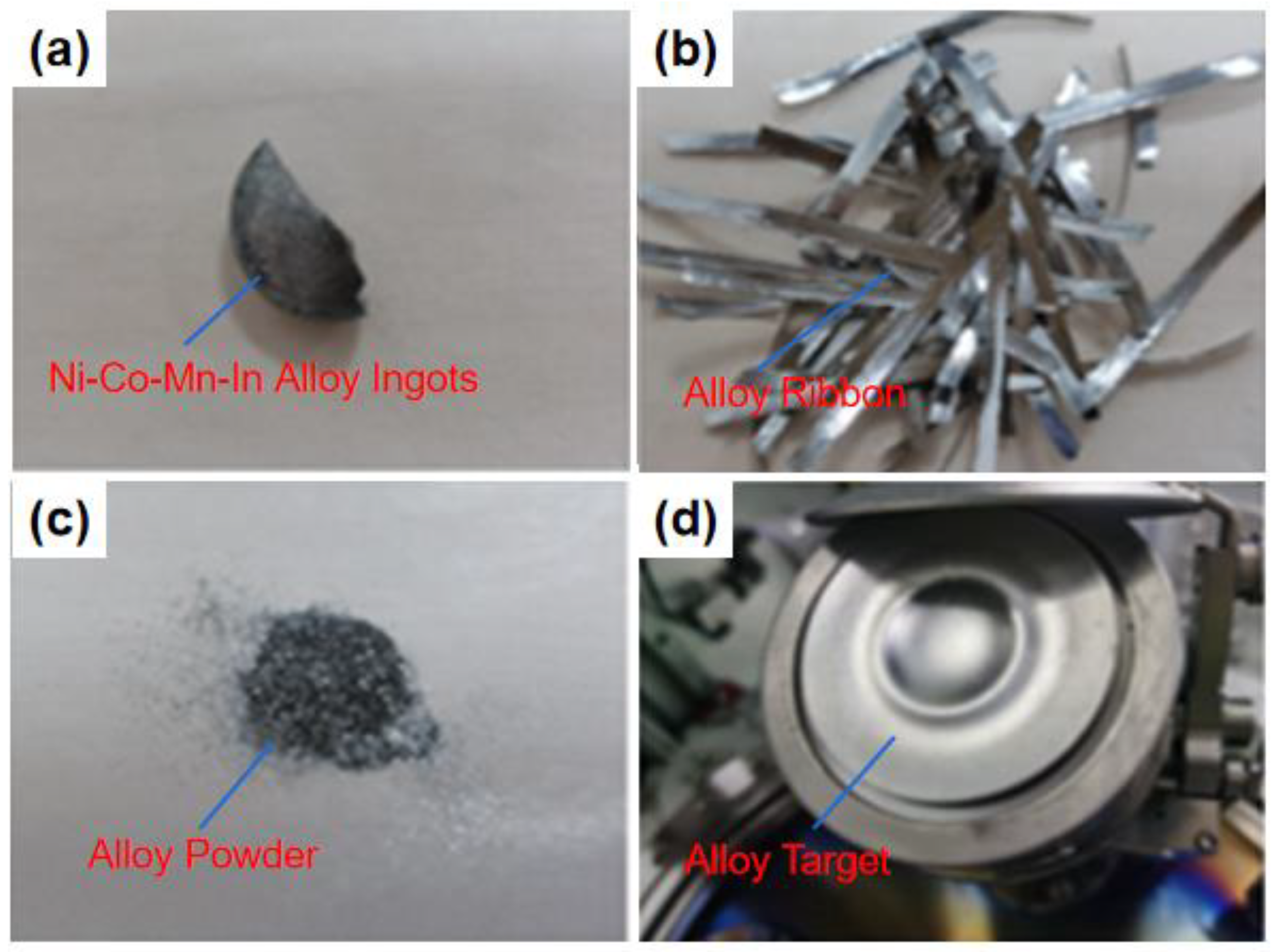
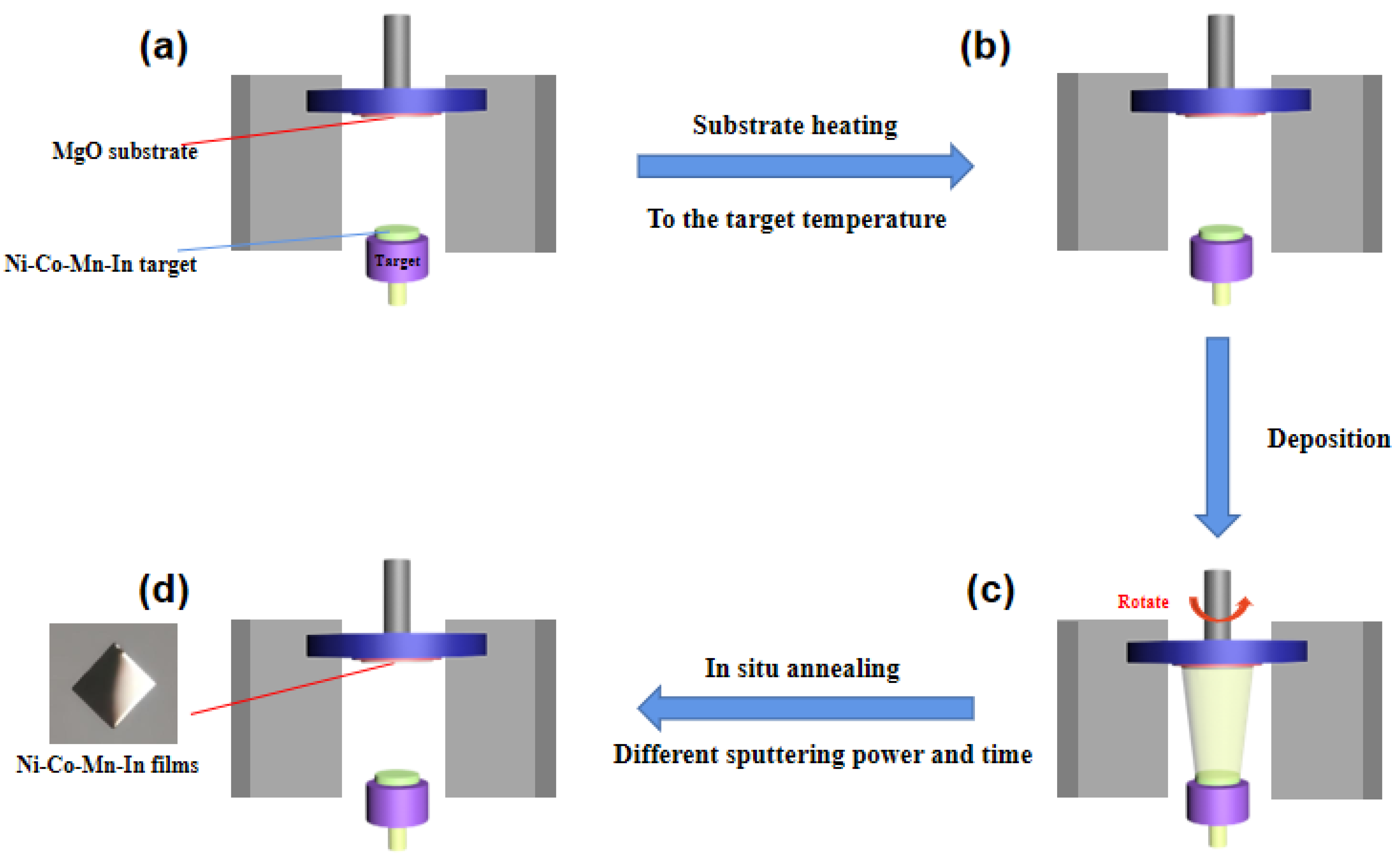
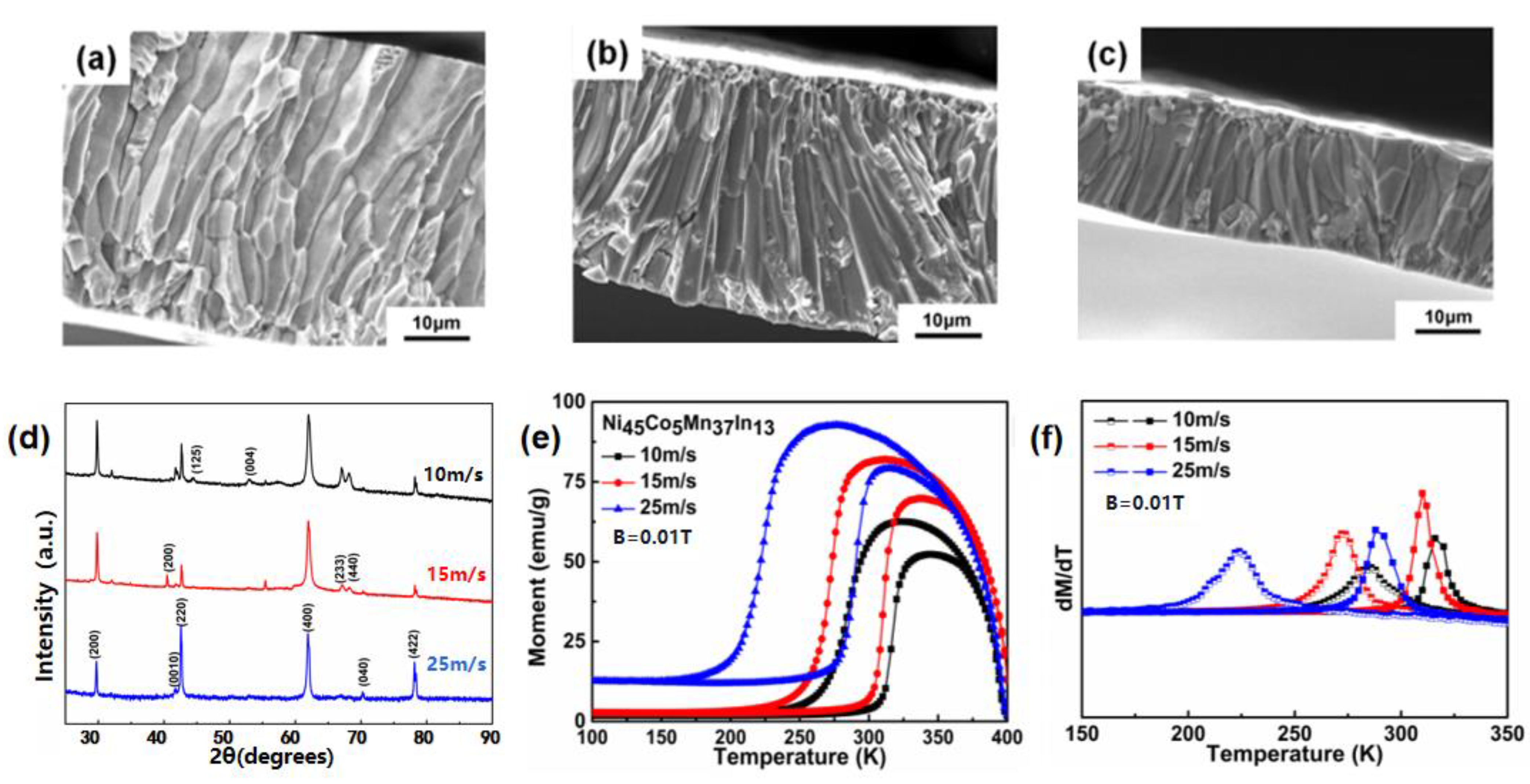
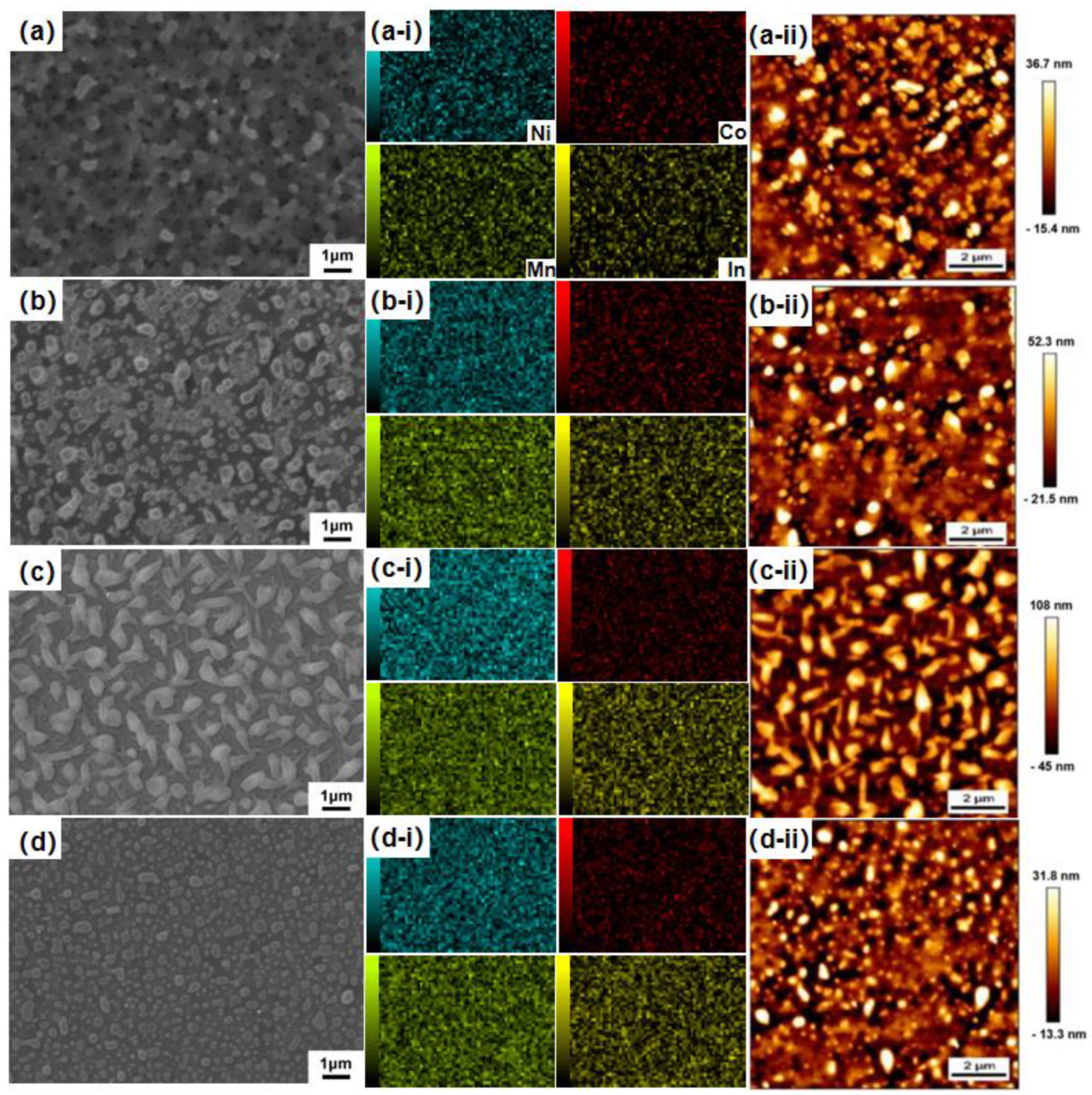

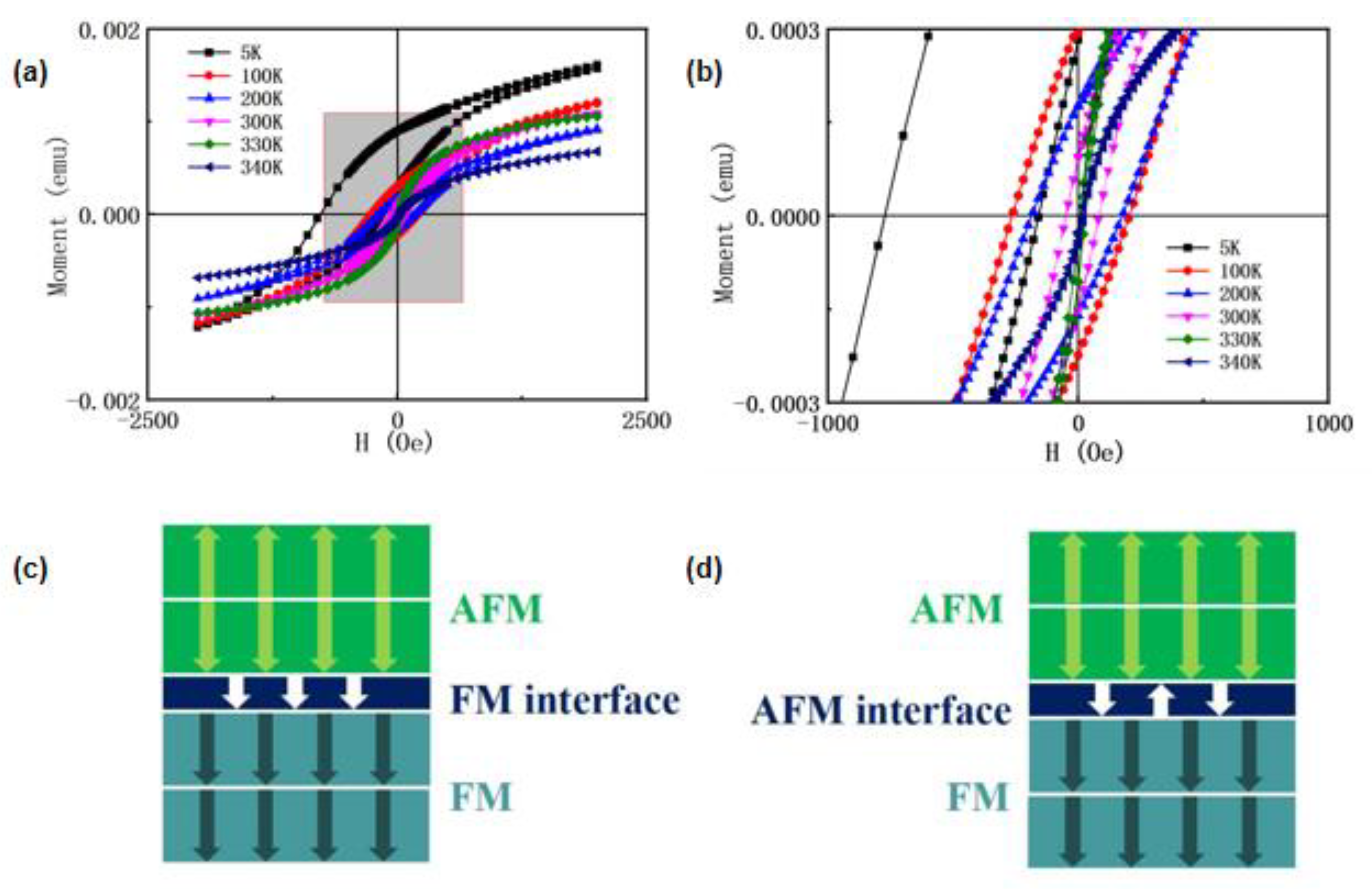
| Samples | Power (W) | Time (min) | Temperature (°C) |
|---|---|---|---|
| #1 | 30 | 30 | 750 |
| #2 | 75 | 30 | 750 |
| #3 | 100 | 30 | 750 |
| #4 | 75 | 40 | 750 |
| Temperature (K) | HL (Oe) | HR (Oe) | HEB = −(HL + HR)/2 (Oe) | HC = |HL − HR|/2 (Oe) |
|---|---|---|---|---|
| 5 K | −772.6 | −158.8 | 465.7 | 306.9 |
| 100 K | −263.8 | 205.0 | 29.4 | 234.4 |
| 200 K | −185.2 | 175.5 | 4.9 | 180.4 |
| 300 K | −49.0 | 83.9 | −17.5 | 66.5 |
| 330 K | 7.8 | 27.4 | −17.6 | 9.8 |
| 340 K | 12.9 | 22.1 | −17.5 | 4.6 |
Disclaimer/Publisher’s Note: The statements, opinions and data contained in all publications are solely those of the individual author(s) and contributor(s) and not of MDPI and/or the editor(s). MDPI and/or the editor(s) disclaim responsibility for any injury to people or property resulting from any ideas, methods, instructions or products referred to in the content. |
© 2023 by the authors. Licensee MDPI, Basel, Switzerland. This article is an open access article distributed under the terms and conditions of the Creative Commons Attribution (CC BY) license (https://creativecommons.org/licenses/by/4.0/).
Share and Cite
Wen, J.; Yang, B.; Dong, Z.; Yan, Y.; Zhao, X. Manipulation of the Martensitic Transformation and Exchange Bias Effect in the Ni45Co5Mn37In13 Ferromagnetic Shape Memory Alloy Films. Magnetochemistry 2023, 9, 51. https://doi.org/10.3390/magnetochemistry9020051
Wen J, Yang B, Dong Z, Yan Y, Zhao X. Manipulation of the Martensitic Transformation and Exchange Bias Effect in the Ni45Co5Mn37In13 Ferromagnetic Shape Memory Alloy Films. Magnetochemistry. 2023; 9(2):51. https://doi.org/10.3390/magnetochemistry9020051
Chicago/Turabian StyleWen, Jiahong, Bochu Yang, Zhichao Dong, Yaxin Yan, and Xiaoyu Zhao. 2023. "Manipulation of the Martensitic Transformation and Exchange Bias Effect in the Ni45Co5Mn37In13 Ferromagnetic Shape Memory Alloy Films" Magnetochemistry 9, no. 2: 51. https://doi.org/10.3390/magnetochemistry9020051
APA StyleWen, J., Yang, B., Dong, Z., Yan, Y., & Zhao, X. (2023). Manipulation of the Martensitic Transformation and Exchange Bias Effect in the Ni45Co5Mn37In13 Ferromagnetic Shape Memory Alloy Films. Magnetochemistry, 9(2), 51. https://doi.org/10.3390/magnetochemistry9020051






